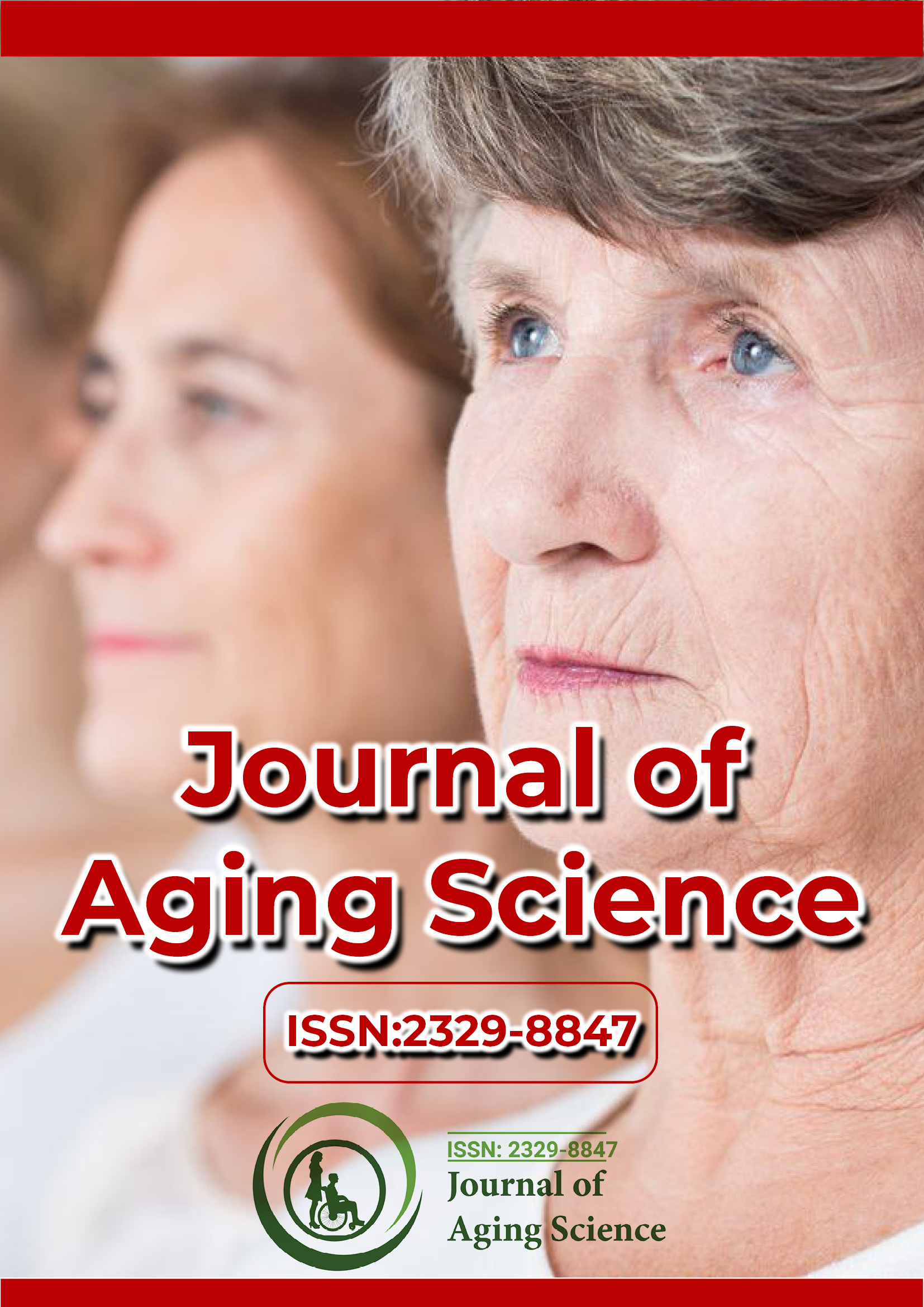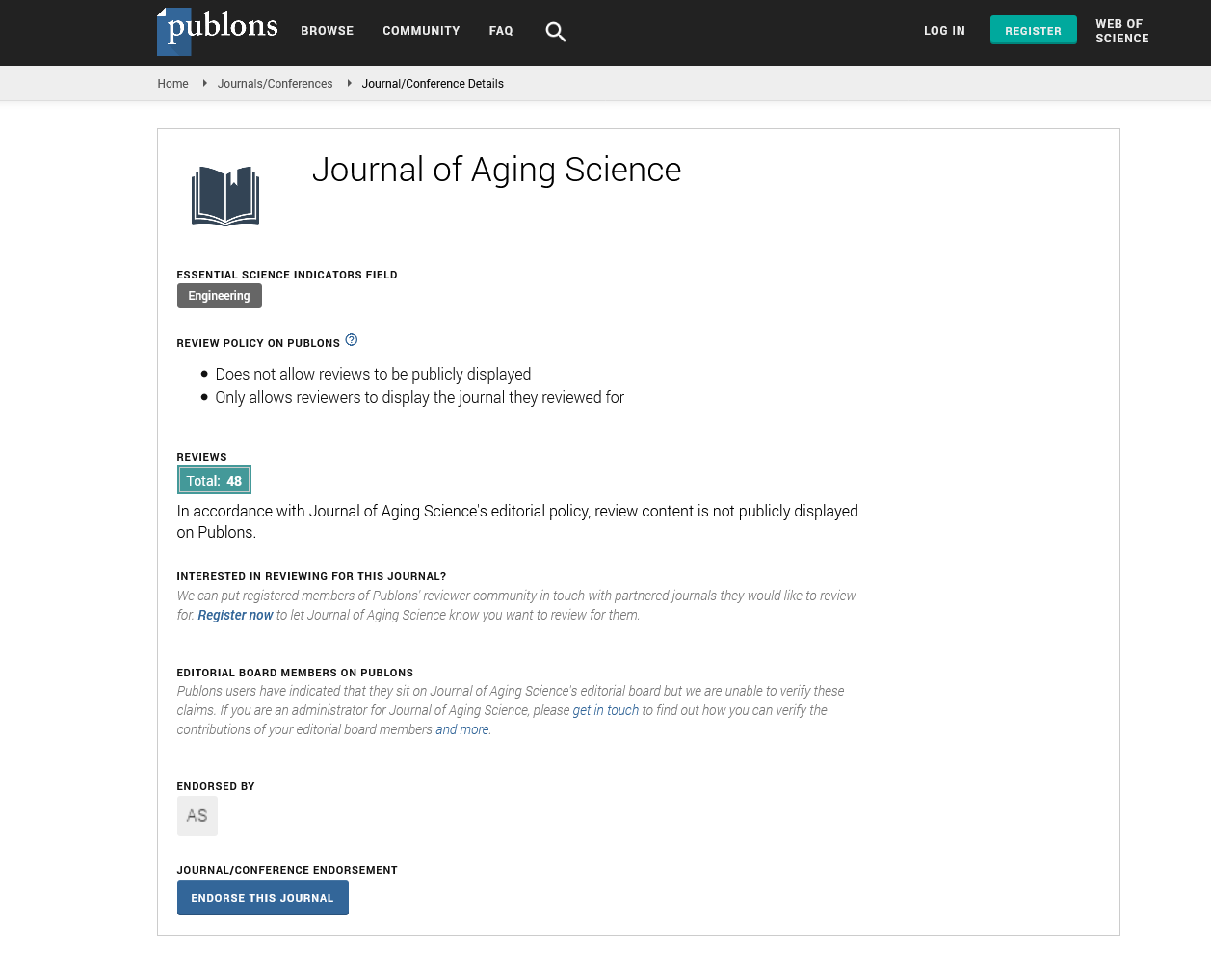Indexed In
- Open J Gate
- Academic Keys
- JournalTOCs
- ResearchBible
- RefSeek
- Hamdard University
- EBSCO A-Z
- OCLC- WorldCat
- Publons
- Geneva Foundation for Medical Education and Research
- Euro Pub
- Google Scholar
Useful Links
Share This Page
Journal Flyer

Open Access Journals
- Agri and Aquaculture
- Biochemistry
- Bioinformatics & Systems Biology
- Business & Management
- Chemistry
- Clinical Sciences
- Engineering
- Food & Nutrition
- General Science
- Genetics & Molecular Biology
- Immunology & Microbiology
- Medical Sciences
- Neuroscience & Psychology
- Nursing & Health Care
- Pharmaceutical Sciences
Commentary - (2024) Volume 12, Issue 4
Epigenetic Modifications and their Impact on Aging and Longevity
Chenchen Yang*Received: 27-Nov-2024, Manuscript No. JASC-24-27783; Editor assigned: 29-Nov-2024, Pre QC No. JASC-24-27783 (PQ); Reviewed: 13-Dec-2024, QC No. JASC-24-27783; Revised: 20-Dec-2024, Manuscript No. JASC-24-27783 (R); Published: 26-Dec-2024, DOI: 10.35248/2329-8847.24.12.392
Description
Aging is a complex biological process characterized by the gradual decline of physiological functions and an increased susceptibility to diseases. While genetic factors play a significant role in determining lifespan, epigenetic modifications are emerging as pivotal regulators of aging and longevity. Unlike genetic mutations, epigenetic changes involve reversible alterations in gene expression without modifying the underlying DNA sequence. These modifications, influenced by environmental factors, lifestyle choices and cellular processes, shape how genes are expressed over time, impacting both the aging process and lifespan. This essay searches into the role of epigenetic modifications in aging and highlights their implications for promoting longevity.
Understanding epigenetic modifications
Epigenetic modifications are chemical changes to DNA and histone proteins that regulate gene activity and chromatin structure. The three primary mechanisms include:
DNA methylation: DNA methylation involves the addition of a methyl group to cytosine bases, primarily at CpG sites in the genome. This modification typically suppresses gene expression. Over time, the DNA methylation region changes, with global hypomethylation and site-specific hypermethylation patterns emerging as hallmarks of aging. These alterations can disrupt gene regulation and contribute to cellular dysfunction.
Histone modifications: Histones are proteins around which DNA is wrapped to form chromatin. Post-translational modifications of histones, such as acetylation, methylation, phosphorylation and ubiquitination, influence chromatin accessibility and gene expression. For example, histone acetylation generally promotes gene activation by loosening chromatin, while histone deacetylation leads to gene silencing. Changes in histone modifications during aging can dysregulate genes involved in DNA repair, metabolism and inflammation.
Non-coding RNAs (ncRNAs): Non-coding RNAs, including microRNAs (miRNAs) and long non-coding RNAs (lncRNAs), regulate gene expression by interacting with mRNA or chromatin. These molecules are critical for maintaining cellular homeostasis and their dysregulation has been implicated in aging-related processes.
Epigenetic drift and the characteristics of aging
With aging, the epigenome becomes increasingly disorganized a phenomenon known as epigenetic drift. This drift is characterized by stochastic changes in epigenetic marks, leading to altered gene expression and cellular function. Epigenetic modifications interact with key characteristics of aging, including genomic instability, telomere attrition, loss of proteostasis and mitochondrial dysfunction.
Genomic instability: Epigenetic alterations, such as aberrant DNA methylation, compromise genome integrity by silencing DNA repair genes. Reduced DNA repair capacity leads to the accumulation of mutations and chromosomal instability, accelerating aging.
Telomere attrition: Telomeres, the protective caps at the ends of chromosomes, shorten with each cell division. Epigenetic factors regulate telomere maintenance by modulating the expression of telomerase, the enzyme responsible for extending telomeres. Dysregulation of these mechanisms contributes to cellular senescence and aging.
Cellular senescence: Epigenetic changes plays an important role in establishing and maintaining cellular senescence, a state of irreversible growth arrest. Senescent cells accumulate with age, disrupting tissue homeostasis and secreting pro-inflammatory factors that drive chronic inflammation.
Caloric restriction and epigenetic modifications: Caloric Restriction (CR), a well-studied intervention for extending lifespan, influences epigenetic marks. CR enhances histone acetylation and reduces DNA methylation at loci associated with longevity genes. It also activates sirtuins, a family of histone deacetylases involved in stress resistance and metabolic regulation.
Epigenetic reprogramming: Epigenetic reprogramming aims to reset the aging epigenome to a more youthful state. Induced Pluripotent Stem Cells (iPSCs) generated through transcription factor reprogramming exhibit rejuvenated epigenetic patterns. This approach has potential for reversing age-associated epigenetic changes and restoring cellular function.
Stress and environment: Chronic stress and environmental toxins accelerate epigenetic drift by disrupting DNA methylation and histone modification patterns. Avoiding exposure to harmful substances and adopting stress-reduction practices, such as mindfulness and meditation, can mitigate these effects.
Epigenetic biomarkers of aging: The study of epigenetic modifications has led to the development of biomarkers that predict biological age more accurately than chronological age. Epigenetic clocks, such as the Horvath clock, utilize DNA methylation patterns to estimate biological age. These tools have applications in assessing the efficacy of anti-aging interventions and identifying individuals at risk for age-related diseases.
Emerging therapeutic strategies
Emerging therapeutic strategies aim to address mitochondrial dysfunction and its role in aging by enhancing mitochondrial health. Approaches include the use of antioxidants to reduce oxidative stress, mitochondrial-targeted drugs and lifestyle interventions like diet and exercise.
Epigenetic drugs: Compounds targeting epigenetic regulators, such as DNA methyltransferase inhibitors (e.g., 5-azacytidine) and histone deacetylase inhibitors (e.g., vorinostat), are being explored for their potential to counteract age-related epigenetic changes.
Gene editing technologies: Advancements in CRISPR-based tools enable precise editing of epigenetic marks, offering the possibility of reversing harmful modifications associated with aging.
Small molecules: Sirtuin activators and BET inhibitors (which target bromodomain proteins involved in chromatin remodeling) are being investigated for their ability to restore epigenetic balance and enhance longevity.
Conclusion
Epigenetic modifications are central to understanding the biology of aging and longevity. By regulating gene expression without altering the DNA sequence, these modifications influence key aging processes and offer a reversible target for therapeutic interventions. Environmental and lifestyle factors further underscore the potential for epigenetic modulation in promoting healthy aging. Emerging therapies targeting epigenetic mechanisms hold great potential for extending healthspan and mitigating age-related decline. Continued research in this field will prepare for innovative approaches to delay aging and improve the quality of life in aging populations.
Citation: Yang C (2024). Epigenetic Modifications and their Impact on Aging and Longevity. J Aging Sci. 12:392.
Copyright: © 2024 Yang C. This is an open-access article distributed under the terms of the Creative Commons Attribution License, which permits unrestricted use, distribution and reproduction in any medium, provided the original author and source are credited.

